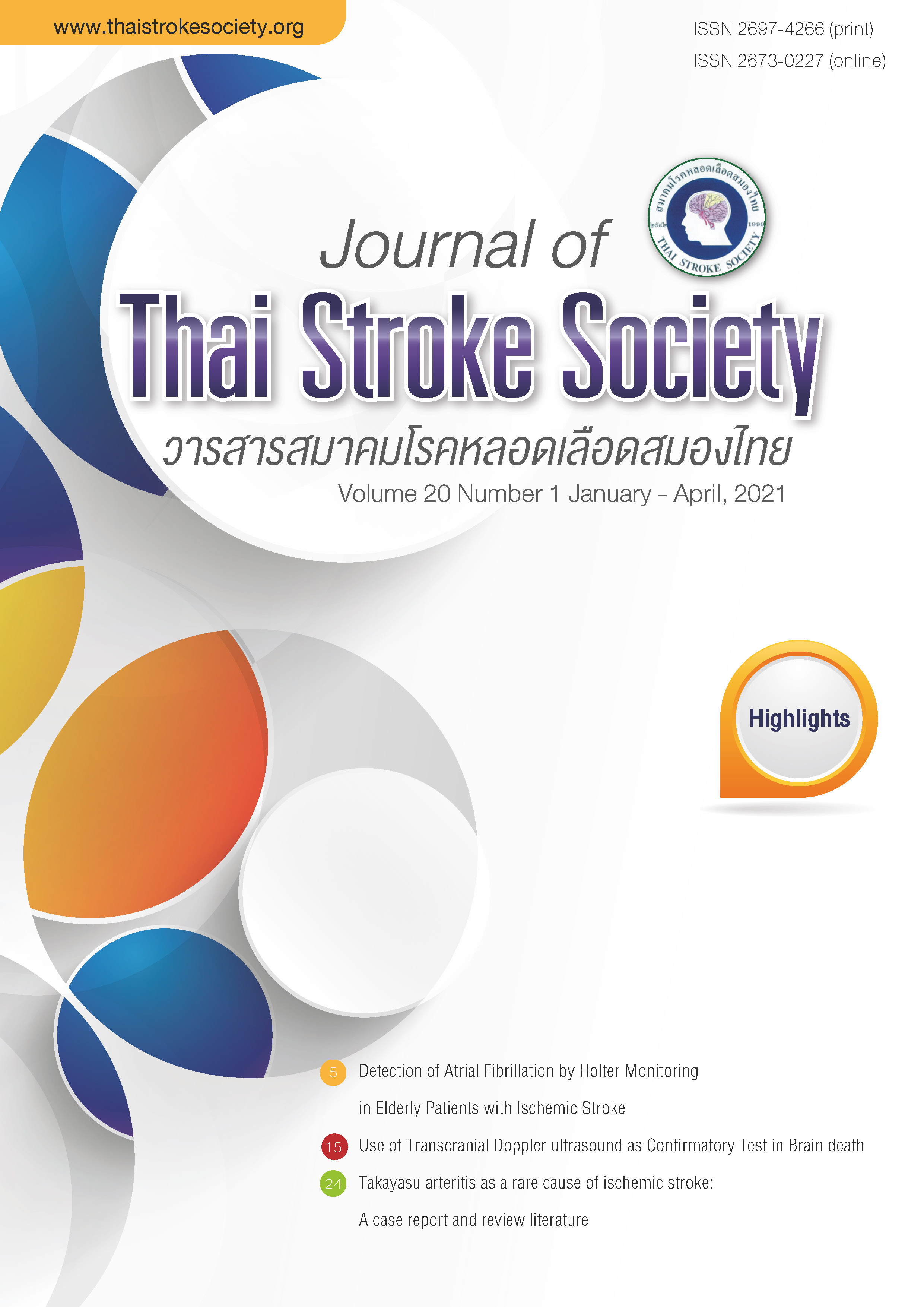Detection of Atrial Fibrillation by Holter Monitoring in Elderly Patients with Ischemic Stroke
Keywords:
Atrial fibrillation, Holter monitoring, Ischemic stroke, Elderly, elderly stroke patient who is aged over 70 years.Abstract
Introduction: Atrial fibrillation (AF) is one of the preventable causes of ischemic stroke. Searching for AF in ischemic stroke patients is very important. But there is low probability to detect and not suitable to use Holter monitoring to detect AF in all patients. However, if selected only for those groups with a higher prevalence of AF, it probably is more appropriate.
Objective: To find the prevalence of AF detected by the Holter monitoring in patients 70 years old or older, hospitalized with ischemic stroke.
Method: All ischemic stroke patients who are 70 years old or older admitted at Trang hospital from June 10, 2014 to October 4, 2019 were prospectively enrolled in order to detect AF by the Holter monitoring for 24-48 hours.
Results: There were 139 patients comprising of 58 males and 81 females with average age of 80.25 years old. The mean monitoring time was 44.03 hours, and 13 patients (9.35%) were found to have AF and there was a higher prevalence in fema le patient (13.58%).
Conclusion: In this study, AF was not an uncommon cause of ischemic stroke in patients 70 years old or older, especially female patients. Holter monitoring will likely be considered in detecting AF in similar groups.
References
Hindricks G, Potpara T, Dagres N, Arbelo E, Bax JJ, LundqvistCB,et al. 2020 ESC Guidelines for the diagnosis and
management of atrial fibrillation developed incollaboration with the European Association of Cardio-Thoracic Surgery (EACTS). Eur Heart J. 2020;0:1-126.
Horton R. Atrial fibrillation and stroke unrecognised and under treated [Editorial]. Lancet. 2016;388:731.
Kamel H, Okin PM, Elkind M, Iadecola C. Atrial fibrillation and mechanisms of stroke. Stroke. 2016;47:895-900.
Flint AC, Banki NM, Ren X, Raw VA, Go AS. Detection of paroxysmal atrial fibrillation by 30-day event monitoring in cryptogenic ischemic stroke.Stroke. 2012;43:2788-90.
Stakhrenberg R, Kruger MW, Seegers J, Edelmann F, Lahno R, Haase B, et al. Enhanced detection of paroxysmal atrial fibrillation by early and prolonged continuous Holter monitoring in patients with cerebral ischemia presenting in sinus rhythm.Stroke. 2010;41:2884-88.
Ustrell X, Pellise A. Cardiac workup of ischemic stroke.CurrCardiol Rev, 2010;6:175-83.
Rizos T, Guntner J, Kenetzky E, Marquardt L, Reichardt RB, Reinhardt R, et al. Continuous stroke unit electrocardiographic monitoring versus 24-hour Holter electrocardiography for detection of paroxysmal atrial fibrillation after stroke.Stroke. 2012;43:2689-94.
Schaer BA, Zellweger MJ, Cron TA, Kaiser CA, Osswald S. Value of routine Holter monitoring for the detection of paroxysmal atrial fibrillation in patients with cerebral ischemic events. Stroke. 2004;35:e68-70.
Chen X, Luo W, Li J, Li M, Wang L, Li B, et al. Diagnostic accuracy of STAF, LADS, and iPAB scores for predicting paroxysmal atrial fibrillation in patients with acute cerebral infarction. J ClinCardiol. 2018;41:1507-12.
Grond M, Jauss M, Hamann G, Stark E, Veltkamp R, Nabavi D, et al. Improved detection of silent atrial fibrillation using 72-hour Holter ECG in patients with ischemic stroke: A prospective multicenter Cohort
Study.Stroke. 2013;44:3357-64.
Dalen JE, Alpert JS. Silent atrial fibrillation and cryptogenic strokes.Am J Med. 2017;130:264-7.
Lotufo PA. Stroke prevention within primary care: management of atrial fibrillation using oralanticoagulation. Sao Paulo Med J. 2018;136:273-5.
Gladstone DJ, Spring M, Dorian P, Panzov V, Thorpe KE, Hall J, Vaid H, et al. Atrial fibrillationin patients with cryptogenic stroke. N Engl J Med. 2014;370:2467-77.
Christiansen CB, Gerds TA, Olesen JB, Kristensen SL, Lamberts M, Lip GY, et al. Atrial fibrillation and risk of stroke: a nationwide cohort studies.Europace. 2016;18:1689-97.
Douen AG, Pageau N, Medic S. Serial electrocardiographic assessments significantly improve detection of atrial fibrillation 2.6- fold in patients with acute stroke.Stroke. 2008;39:480-2.
Wang Y, Qian Y, Smerin D, Zhang S, Zhao Q, Xiaoxing X. Newly detected atrial fibrillation afteracute stroke. Cardiology. 2019:112-21.
Powers W, Rabinstein A, Ackerson T, Adeoye O, Bambakidis N, Becker K, et al. Guidelines for the early management of patients with acute ischemic stroke: 2019 update to the 2018 guidelines for the early management of acute ischemic stroke. Stroke. 2019;50:e344-e418.
Ding M, Fratiglioni L, Johnell K, Santoni G, Fastbom J, Ljungman P, et al. Atrial fibrillation, antithrombotic treatment, and cognitive aging.Neurology. 2018;91:e1732-e40.
Wilkinson C, Todd O, Clegg A, Gale C, Hall M.Management of atrial fibrillation for older people with frailty: a systematic review and meta-analysis. Age Ageing. 2018;0:1-9.
Huang WY, Lee M, Sung SF, Tang SC, Chang KH, Huang YS, et al.Atrial fibrillation trial to evaluate real-world procedures for their utility in helping to lower stroke events:A randomized clinical trial. Int J Stoke. 2020;0:1-11.
Sacco RL, Kasner SE, Broderick JP, CaplanRL,Connors JJ, Culebras A, et al. An Updated Definition of Stroke for the 21st Century .Stroke. 2013;44:2064-89.
SribunditN, Riewpaiboon A, Chaikledkaew U, Stewart JF, Tantirittisak T, Hanchaipiboolkul S. Cost of acute care for ischemic stroke in Thailand. Southeast Asian J Trop Med Public Health. 2017;48:628-40.
ArboixA,Josefina,Alió j.Cardioembolic stroke: clinical features, specific cardiac disorders and prognosis.CurrCardiol Rev, 2010;6:150-61.
Kamel H, Healey JS. Cardioembolicstroke. Circ Res. 2017;120:514-26.
Kishore A, Vail A, Majid A, Dawson J, Lees RK, Tyrrell PJ, et al. Detection of atrial fibrillationafter ischemic stroke or transient ischemic attack.Stroke. 2014;45:520-6.
Jhawar MB, Flaker G.Preventing stroke in atrial fibrillation patients – clinical utility of oral anticoagulants. J Blood Med. 2012;3:1-13.
Downloads
Published
How to Cite
Issue
Section
License
ข้อความภายในบทความที่ตีพิมพ์ในวารสารสมาคมโรคหลอดเลือดสมองไทยเล่มนี้ ตลอดจนความรับผิดชอบด้านเนื้อหาและการตรวจร่างบทความเป็นของผู้นิพนธ์ ไม่เกี่ยวข้องกับกองบรรณาธิการแต่อย่างใด การนำเนื้อหา ข้อความหรือข้อคิดเห็นของบทความไปเผยแพร่ ต้องได้รับอนุญาตจากกองบรรณาธิการอย่างเป็นลายลักษณ์อักษร ผลงานที่ได้รับการตีพิมพ์ในวารสารเล่มนี้ถือเป็นลิขสิทธิ์ของวารสาร





